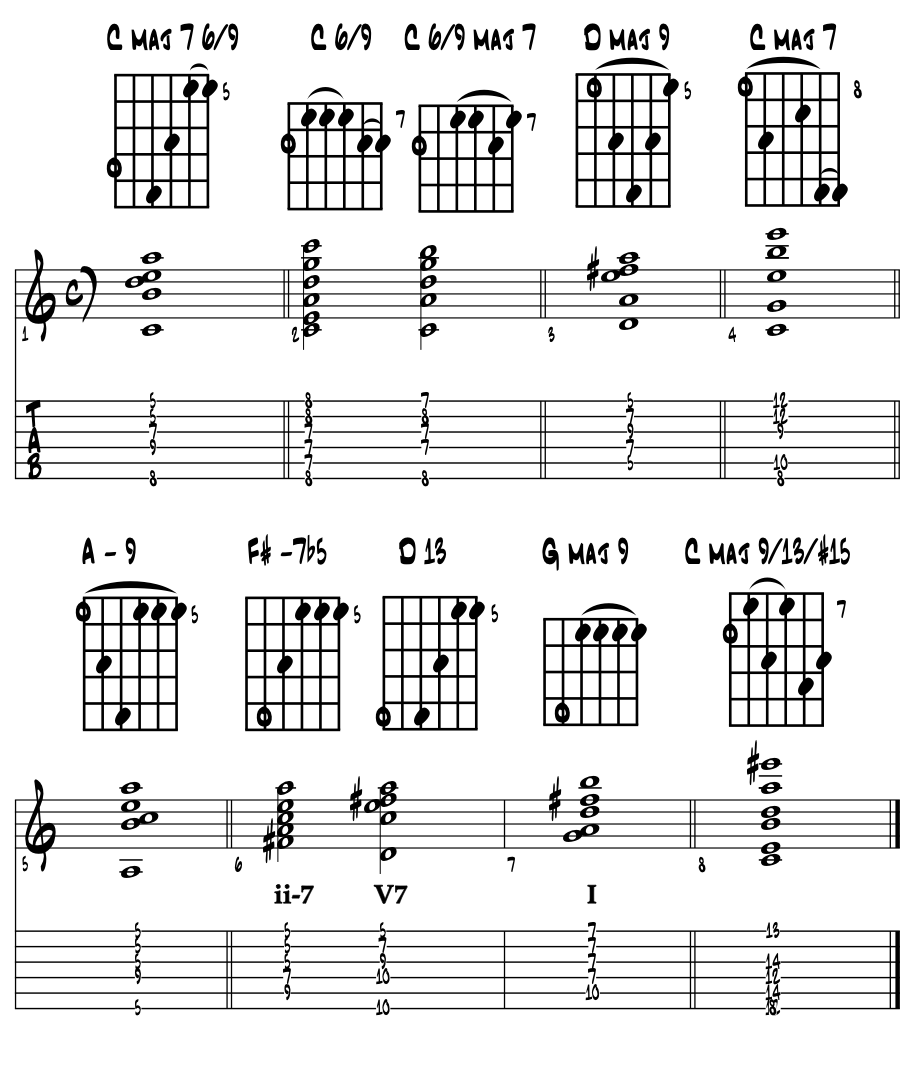In a nutshell. Today, we can create multiple note / pitch chords to support our melodies in any music style. And a chord 'voicing' is just how we theorists describe how we stack up and arrange its pitches. All the various types of pianos ~ keys and guitars ~ strings and frets, are our common chord making instruments. On piano we can voice chords easily as the keys lay out the notes in perfect vertical and linear fashion. On guitar, not so easy, as pitches are horizontally stacked. Luckily our most common and now ancient guitar voicings just happen to correspond with what Mother Nature thought is a good way to stack up the pitches. Bigger intervals in the low notes and high notes closer together are built right into guitar voicings. |
Which pitches we choose and how many, helps us to place any chord within our spectrum of musical styles. And once we choose our pitches, how we stack them up in a 'voicing' and motorize them with a rhythm, helps shape the vibe and essences' of our musical styles. Recognize any of these voicings by style ? Thinking mostly 'A' minor, adding one pitch at a time. Example 1. |
1bass 2/metal 3/triads 5/open 6/bar 4/no-double |
 |
Find any you know? Click its link to the right here and explore the numerics of it all ... and the art that lives there too :) And depending on the styles you dig, there are tried and true ways chords are voiced. Common theory questions could be; are some chord pitches doubled? Are there any colortones added to triads? Are we using a capo? Open tuning your instrument? Read on here to get the scoop. |
How chords come to be. All our musics in the early days we're really just one melody line motored by various rhythm instruments, centered on the heartbeat of the drums and the dance tempos it creates. As things evolved, one melody line became two, then three, then four lines moving together in time. Today we call this style of writing polyphony, associate it with the Baroque Era and thus J.S. Bach. |
|
When the notes were sounded together, we started to 'hear' intervals, the basis of chords being formed. And based on the way Mother Nature likes the pitches to be arranged, we theorists began to try and recreate chords from each of the pitches in our melodies. Today we call this to 'harmonize a melody.' |
Eventually, as say in around the 1500's, string players, well those with frets, started to play the chord 'changes.' Composers started to think, and write, in a more vertical fashion, positioning the notes to sound together as chords. And as the tuning of the pitches evolved towards our present day equal temper for all 12 pitches, all sorts of chords and combinations appeared, that emotionally supported melodies, melody notes, a song's words and even one word, with 'one chord.' So ... power chords? Yep, they just didn't have the big roar yet :) |
This becomes a super dramatic, evolutionary palette expander for composers, in their personifying a song's emotional storyline in musical tones. Imagine a more perfect emotional musical capture, in one sweep of the hands ... :) Combinations of musical tones we today simply call our chord 'voicings.' |
Be the choir with chords. The idea of voicing a chord basically follows along with the voices normally found in a full vocal choir. So bass, tenor, alto and soprano. And with six strings and pitches all generally available, we guitarists usually have choices in how to stack up our pitches. So just like a regular choir of singers, we too have 'sections' that combine to make the whole sound. From the lowest bass pitches and up through middle tenor, alto notes to soprano notes on top. Example 1. |
|
 |
This last idea contains the basis for so much of what we do in creating chords. And while there's endless variations, when we play a folk song, if we want to create the vibe and keep the gig, chances are we're playing 'voicings' that are very similar to this last one. And even when we change chords, each of the voicings follow along the same ways for stacking the pitches. Each of our main musical styles has their own cherished chord voicings. For we've been 'voicing' chords now for a couple of hundred years and if it works, it works :) Yet, might you need or are looking for something new ? |
So just what is a chord voicing? A chord's 'voicing' is simply the arrangement of its pitches. Any one chord we come across could be said to be 'voiced' a certain way; 'root (1) 3 5', or 'root 5 3', or 'root 5 7', 'root 7 3 5' etc. Examine some basics using letter names for pitches thinking 'C' major. Example 2. |
arpeggio # degrees |
1 |
3 |
5 |
7 |
9 |
11 |
13 |
15 |
C major arpeggio |
C |
E |
G |
B |
D |
F |
A |
C |
1 3 5 |
C |
E |
G |
. |
. |
. |
. |
. |
1 5 3 |
C |
. |
G |
. |
. |
E |
. |
. |
1 5 7 3 |
C |
. |
G |
B |
E |
E |
. |
. |
1 7 3 5 |
C |
. |
. |
B |
E |
G |
. |
. |
Cool? So the original ~ organic basis of voicing chords comes from the mother herself, Mother Nature. We initially sound out the pitches in a chord voicing, reflecting the way our naturally occurring overtone / harmonic series presents and gives the pitches to us. Have you ever seen the pitches written out and arranged this way ? Example 3. |
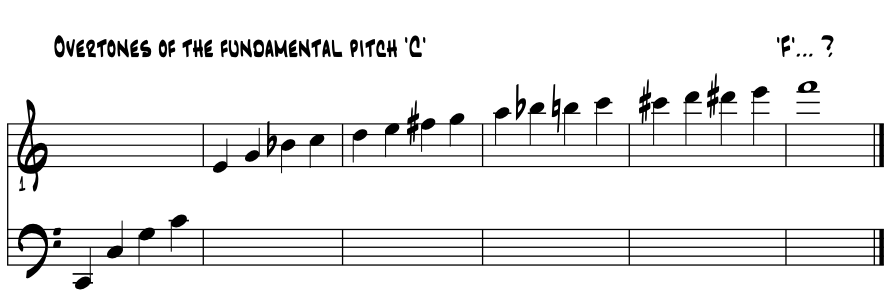 |
Cool? Ya hip to this fundamental magic of our natural musical sounds? Begin to learn it here if need be and explore forevermore, for there's a ton to learn about this topic for those curious in a myriad of disciplines within music. Science for sure, history of its early discovery and building up our music theory around it, mythology, and legend of course, there's always legendary stories associated with music n'est-ce pas? Forming up the basis of many aspects of our musics, this series of pitches is around whenever 'sound design' comes into play. With whatever your art is, this organic arrangement of the pitches will be a part of its basis. And of course, they go all the way back to the beginning :) |
In the mud. Generally with voicings, we put wider intervals between the lower pitches of a chord. This is especially true with piano, which has those colossal sized lower strings. Get pitches to close in the lower register and the 'mud' begins to seep into the voicing, clouding up our harmony colors. So if ya need some mud, like you're trying to sound like being at the bottom of the river, put low notes close together. Otherwise ... |
|
Root / octave / 5th / octave / 3rd. From the first pitches of the overtone series, we get the basic clues for 'wider' intervals towards the bottom of our stack of pitches. Here's the pitch series again. Example 4. |
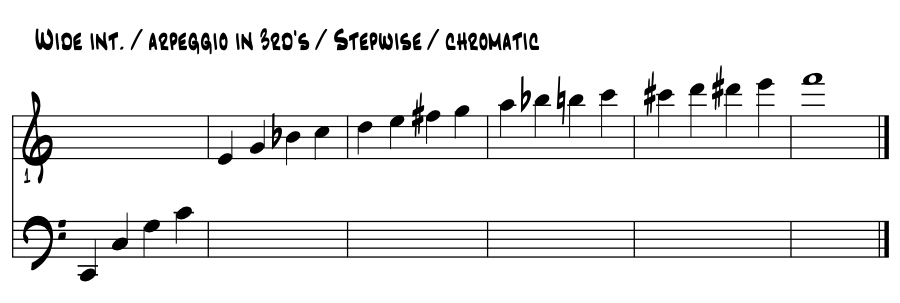 |
Wide interval, arpeggio / stepwise chromatic. In the first three intervals of measure one, measuring from our fundamental pitch, we get an octave, then a 12th, then second octave. Then from our 2nd overtone, we get a major 10th. These form initial basis for our keyboard voicings, which we then apply to the guitar as best we can. Look closely, for that fourth pitch in measure one is our written 'middle C' of any common keyboard. Once into this range, and this is the common range we use for guitars, our 'muddy' begins to clear. And from this point and higher in pitch, near any combination of pitches in creating chords will potentially work. Both for guitar and piano. |
Two things to consider for piano and guitar voicings. The piano has a sustain pedal, so we can push a button and sustain any and all pitches to build up chords. These we generally create as arpeggios on guitar. Second, that the guitar's written pitch sounds an octave lower than written. Thus we call it a transposing instrument. Compare the written pitches (no sound file). Example 5. |
 |
Common piano voicing basics. Here's a couple of voicings that sound fine on the piano. Wider intervals in the bass / left hand, closer on top for the right. Ex 5a. |
 |
These basics will work with any chord. Just keep watch on your registration. |
Voicings for guitar. On our guitars, our pitches are already high enough in register so that near all of the 'mud' associated with too low bass notes, too close together, is eliminated. So we can go 3rd's, 5th's, 7th's, octaves of course. So our basic chord building blocks / intervals are all in play. From the low 'E' string. We simply find these intervals from each of our lowest three pitched strings. This is the basis of our 'root position' chord vocabulary. Thinking from the low 'E' string, examine the following shapes for a few 'G' major chords. In this register, all of these voicings will work at the piano. And always adjust as needed. Example 6. |
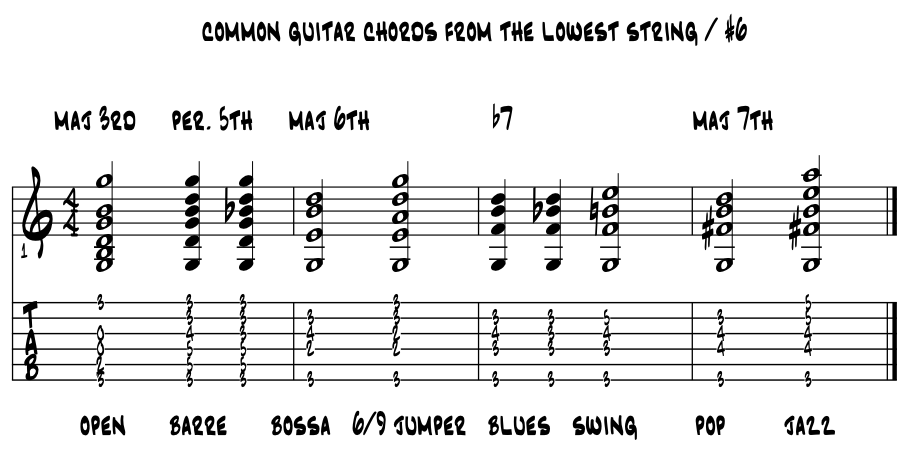 |
About these last few chord voicings / low 'E'. Yeah ... so yea groovy, the whole tamale really. Oh, here the two minor chords slipped in? Starting from the left, a bit about each chord. A 'super doubled up triad open 6'er then evolves to a ... Full on movable voicing / barre chord shape of a core three note cluster, 60's total analogue power chord shape, completely movable, once mastered, completely movable chords. Major made into minor with the flick of a finger. Core bossa nova, fully movable chord voicing / shape. Jump for joy! Maybe leave the root off of this till the last hold, the upper four, close voice, just love to bring it. Essential blues chord, fully movable and rootsy organic, easy reshape into minor 7th color. This voicing is a super Two, fully movable chord shape. Cool blues, V7 / 13 that packs a wallop, swings hard. "Look at me ...", the classic transitional chord color from 'bubblegum' to 'pop jazz' and very often opening us up into a different sort of crafting / composing process, where motion to Four takes on it's own weaves too. Hollywood chord for sure, fingerstyle jazz cats love these voicings as they really offer the plucking hand with lots of ways to orchestrate the mix moving through time. |
From the low 'A.' Moving up to the fifth string to find our root pitch, so thinking mostly 'C.' Please examine these guitar chord voicings. In this register, all of these will work at the piano. Example 6a. |
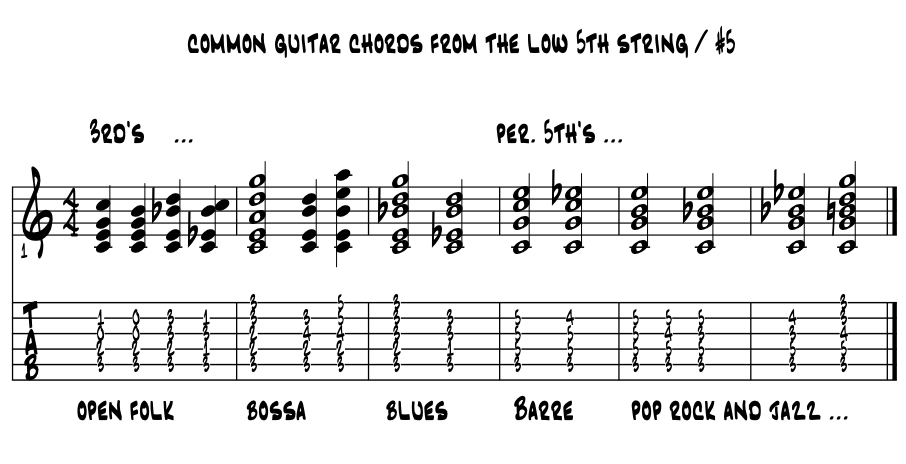 |
About these last few chord voicings / low 'A'. Yeah, open chord 'C' is in a million tunes by now, probably. Voiced '1 3 5' is the mantra here. For kids and folk songs, while tricky shape to move, find yourself some finger picking patterns / rhythms and recreate its now ancient weaves. Tune a bit back to 'A' = 432 hz. to sweeten up the ancient. We evolve this voicing by adding a the two 7th's available and the 9th. Bossa 6/9 again, same as above with a new root pitch. The two blues voicings in the middle are common and essential to the style. The 'C' major barre voicing in measure 4 is a pop and rocker's delight. Early styled power chord too. Bar minor 7th voicing and a tonic major 7th to close the line. Find any new coolness? |
From the low 'D.' Moving up to the fourth string find to our root pitch, so thinking 'D' and then 'F' as we move up the neck. In this register, all of these voicings will work at the piano. Examine these chord voicings. Example 6b. |
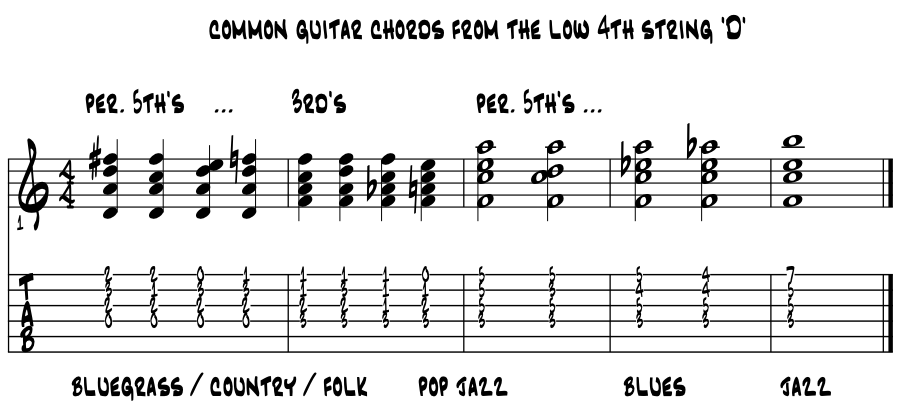 |
About these last few chord voicings / low 'D'. This first open 'D' voicing, built on the interval of a perfect 5th, motors a lot of music. It's the V chord of 'G', and there's a lot of songs in 'G'. 'G C D'ers' we used to call them, just a true '1 4 5' chord progression in the key of 'G.' In the second measure, major chord, a 6th chord that really jumps, then a minor 7th which becomes a great Two chord shape. The last two voicings, a major 7th color then with an added #11, move us towards jazz stylewise. |
|
From the low 'G.' Moving up to the third string to find our root pitch, so thinking mostly 'G' as we move up the neck. In this register, all of these voicings will work at the piano and beyond. These next few voicings / shapes are more 'pieces' of chords, but have brought some big magic over the last couple of hundred years. Please examine these three note guitar chords voiced mostly in 3rd's. Example 6c. |
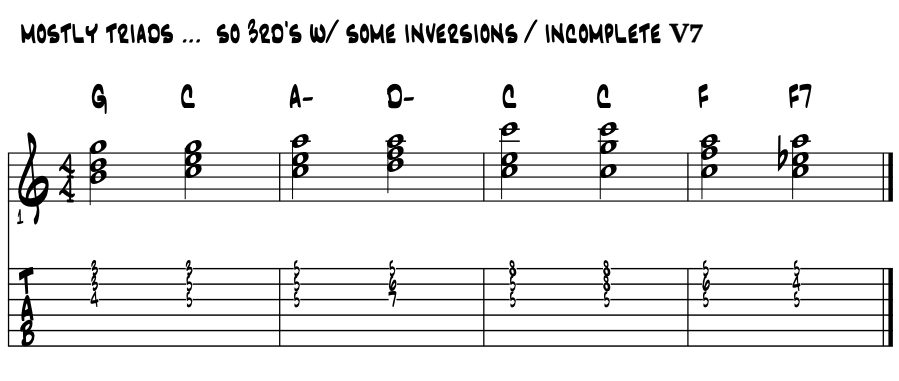 |
What no root pitch ... ? This first open 'G' voicing is a 1st inversion triad followed by a 'C' triad. The 'A' minor of measure two is also a 1st inversion triad. The 'D' minor triad is a nice symmetrical, fully movable chord shape / arpeggio, that yields some way cool ideas. Be creative. The 'C' chords in measure three are the 'endcaps' of the original 'box' scale from wayback. The 'F' triad shape is in second inversion and is the same shape as an open 'D' chord, just moved up a few frets. The last chord, also thinking from the root 'F', is an incomplete V7 chord. 'Incomplete' in that it'll function as 'F'7 / V7, but there's no root pitch in the voicing. Oh well, just can't have everything every time :) |
Inversions of triads. Inversions of the pitches of a triad form another way to voice chords. For while we love to 'think from the root pitch of the chord', sometimes we need a different weighted chord, or we have a bass player, or piano, in the mix. We can 'lighten' our voicings by leaving out the root. Three pitches in a triad form the basis of three inversions, each one gets a chance to be the lowest pitch to support its buddies. Thinking 'C' major then 'F', motion to Four via 1st inversion voicings as a passing chord. Example 7. |
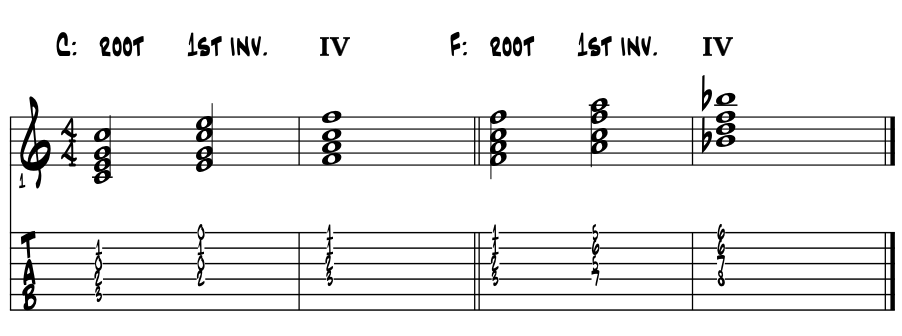 |
Inversions of triads make lovely passing chords. In the last idea, we used an chord voicing / inversion to create a smoother motion to Four. Through this process we jazzed up the motion by adding in a bit of a bass line, that used a chromatic motion to land us on Four. The pitches; 'C to E to F.' Cats call this voice leading mostly, meaning how the pitches of one chord become the pitches of another. Here's 'C' to 'F' with some fancier color tones. Example 7a. |
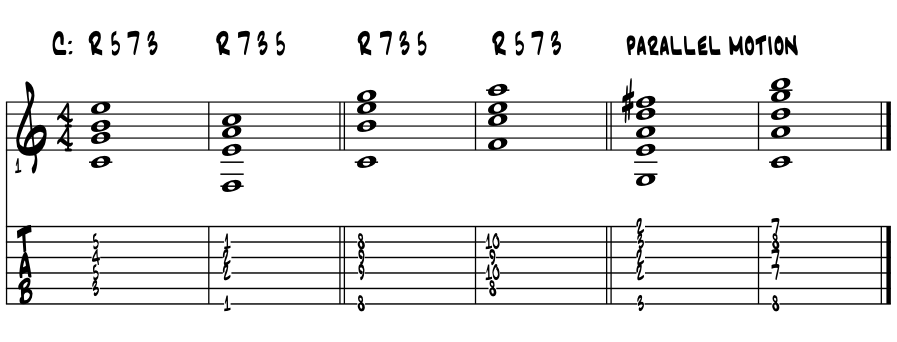 |
Pitch by pitch. From this last idea, let's extract the first two voicings and go pitch by pitch and see which voice does what when moving to the next chord. Example 7b. |
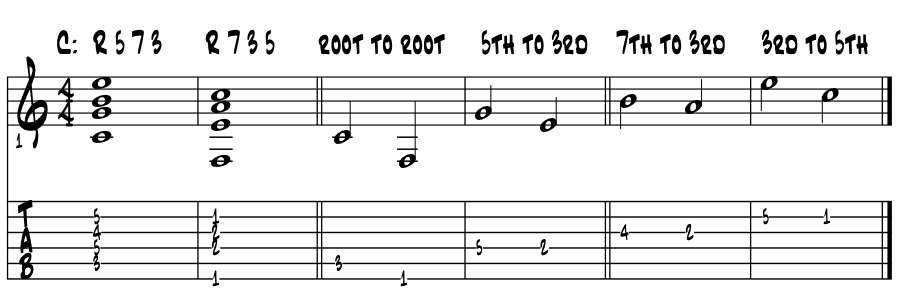 |
All voices same direction? Cool with the breakdown? One by one we can figure a way to bring each pitch into the next chord. Root to root by 5th, is most common and has been this way for a long long time. It's inverse interval, the perfect 4th, so up a 4th, even more so. The 5th of 'C' moves a minor 3rd to become the 7th of 'F.' The 7th of 'C' moves by whole step to become the 3rd of Four. And the 3rd of 'C' moves two whole steps to the 5th of 'F.' So, notice how all of the voices move downward? All? Yep. Common? Yes and no. Any and all options are available. Whatever sounds best to you will be a good solution in moving chords one to another. |
To double or not, that is the question. The idea of 'doubling' a note in a voicing simply means we've more than one of the same pitch in a voicing. Do examine the following shape / voicing of a major triad. Example 8. |
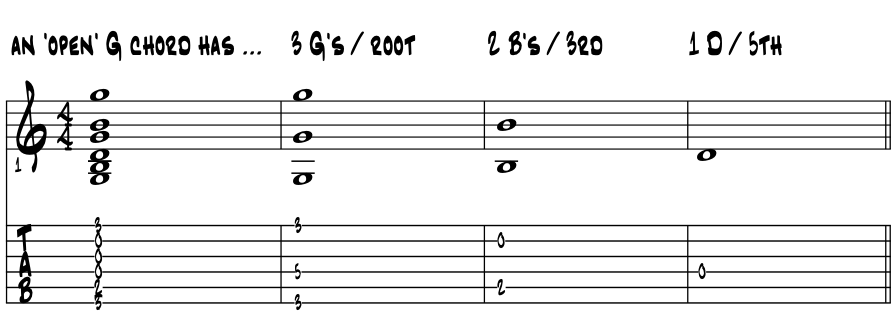 |
Tripled ! So we've three 'G's in this voicing? Yep, three out of six pitches. On top, in the middle and as the root of the voicing. Common? Well, depends on the style of music we're making. Need a big 'G' chord to rock the house on acoustic? Grab this chord voicing, start your motor and commence a jammin' ! Guitar open chords, and triads both major and minor, near all of which have some variety of 'doubled' pitches, generally hang towards the kid's songs, folk, bluegrass, country points along our musical style spectrum. |
A theory perspective. So, all through this 'e' primer we're talking about 'number of pitches and musical style.' Creating a near endless array of comparisons between the number of pitches in a particular ____ thing, and where we'll most likely find it within the fabric of our Americana musics. |
Thusly intellectually empowered, we can know or discover by our own labors, the organic source of the colors. To locate, create and borrow from one style to another whenever necessary, to create our own 'genre' of expression, the basis of being a 'modern' artist. Cool? |
A giant step beyond / add Seven. In the last example we triple / doubled up on the root and 3rd of our 'G' major / open voiced chord. A first evolutionary step in growing our chord voicing options is to reduce or eliminate this doubling of pitches within a chord. An easy and important way to do this is to add a 7th to our triads. We've two 7th's to choose from, major and minor. Thinking in 'G' major, examine the letter name pitches and then their sounds. Example 9. |
scale degrees |
1 |
2 |
3 |
4 |
5 |
6 |
7 |
8 |
G major |
G |
A |
B |
C |
D |
E |
F# |
G |
G / major 7th |
G |
. |
. |
. |
. |
. |
F# |
. |
G / minor 7th |
G |
. |
. |
. |
. |
. |
F |
. |
 |
Softening the major triad a bit with a major 7th, we start down the 'pop-ish' road and begin a 'jazz it up' pathway. And adding in a dominant blue 7th? Sure, make any triad into a V7 chord type by adding a 'blue 7th', and bluesify most any spot in any Americana music. Here's a few triad / doubled voicings 'softened' and un-doubled by adding a major 7th to the three notes of a triad. Ex. 9a. |
 |
Softening the major triad a bit with a minor 7th, bring some blues, V7 and our harmonic traffic cop. Devolving our 'doubled' up triads into our bluesy V7 traffic cop. Example 9b. |
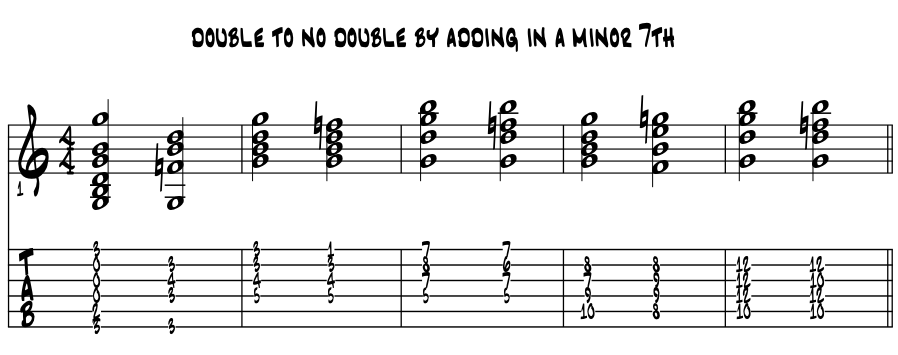 |
So we can catch all of the basic voicing intervals here, 3rd's, 5th's, 7ths. We add in a tritone, did you catch the '3rd inversion' V7 chord of bar 4 ? 'F B E G?' Super giant fun, totally movable 13th chord, that can swing BIG :) |
Over a minor triad. Continuing on with the same process here, of 'undoubling' our triad voicings by adding in a 7th. Here we add both 7th's, major and minor, to our three note, minor triad. Thinking here more in terms of common chord shapes than in a particular key center. Example 9c. |
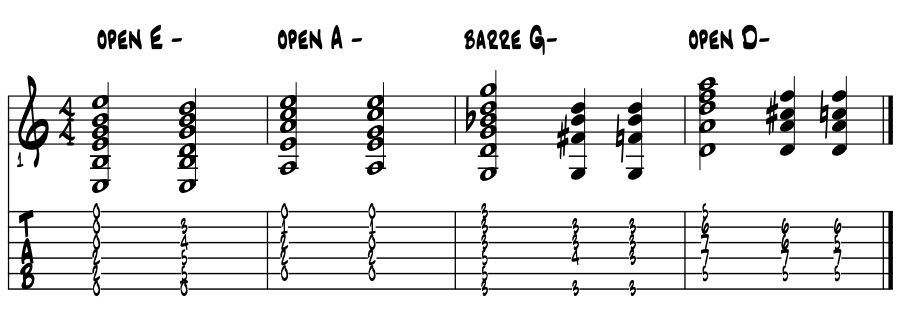 |
The open chords love to double up chord pitches. Its a big part of bringing a big sound to nature of the instrument, a wooden instrument with strings, percussive and with a range of dynamics. These two open chords are common and true keepers for the folk and vocal storytelling artists. The barre chord on 'G' begins the 'no double' process, and on 'D', we get a bit of a tricky fingering which solves our 'double / no double' task. |
|
"Put in a Hollywood chord there ol'e boy :)" Doc had a handful of some very fancy chords with that West Coast Hollywood level studio orchestrated coolness and wow for its bright lights and bigger stars. All movable shapes in root position, here's the ones recalled. Ex. 1. |
Nice huh? Doc knew them all, send good vibes as I get to pass his wisdom along to you. Oh, and the last disaster chord, the #15 is all mine :) Yet, the theory of it comes from one of Dr. Miller's colleagues of maestro magics, jazz pianist Dr. Alan Frank. |
Review. In creating chord voicings, we generally try to follow along with what Mother Nature provides in our organic overtone series. This gives us wider intervals in the bass notes and with pitches close together on the top. When we move beyond the triad and reduce or eliminate our 'doubled' pitches in a chord, we begin to see a stylistic shift. The 'b7' over the major triad gives us a V7 and the blue hue. The 'b7' over a minor triad can easily become the sleeker Two chord type, setting us in a jazz direction. The major 7th added to a major triad begins a move towards a pop sound and on into jazz. For piano, when working around middle 'C', keep wider intervals between bass notes and chord tones, let your ear decide what works for the art you create. In this range and location, a 10th interval between a bass note and the 3rd of a chord is a good start point in creating voicings. These basics will work with any chord. Just keep watch on your registration to keep things clear. And if you want to bring the mud, just thicken up the bottom of any chord really. |
Next? Ready to add in some more color to our triads via the color tones? |


